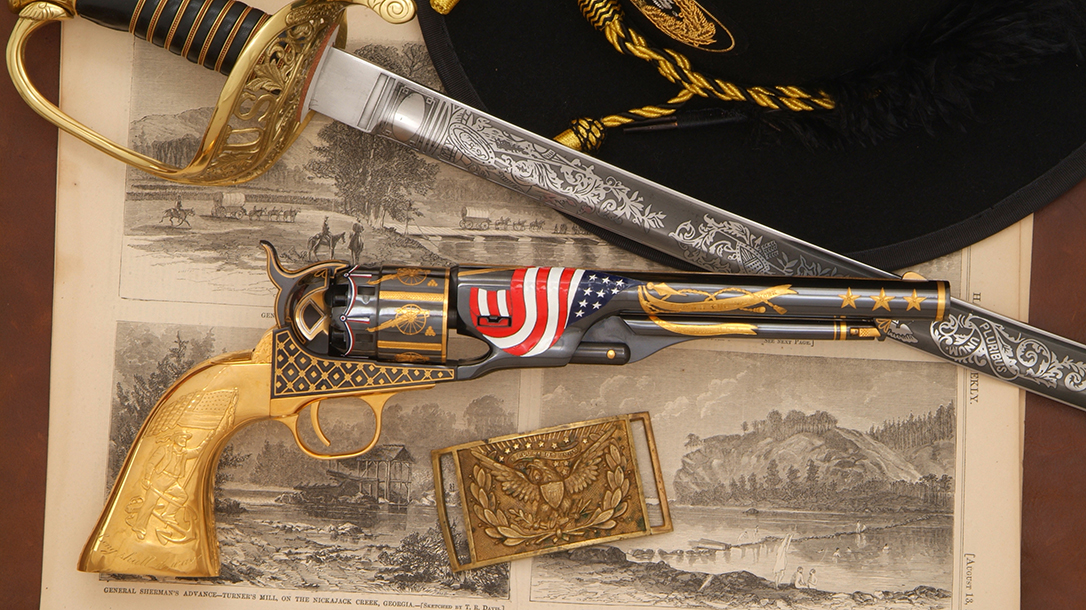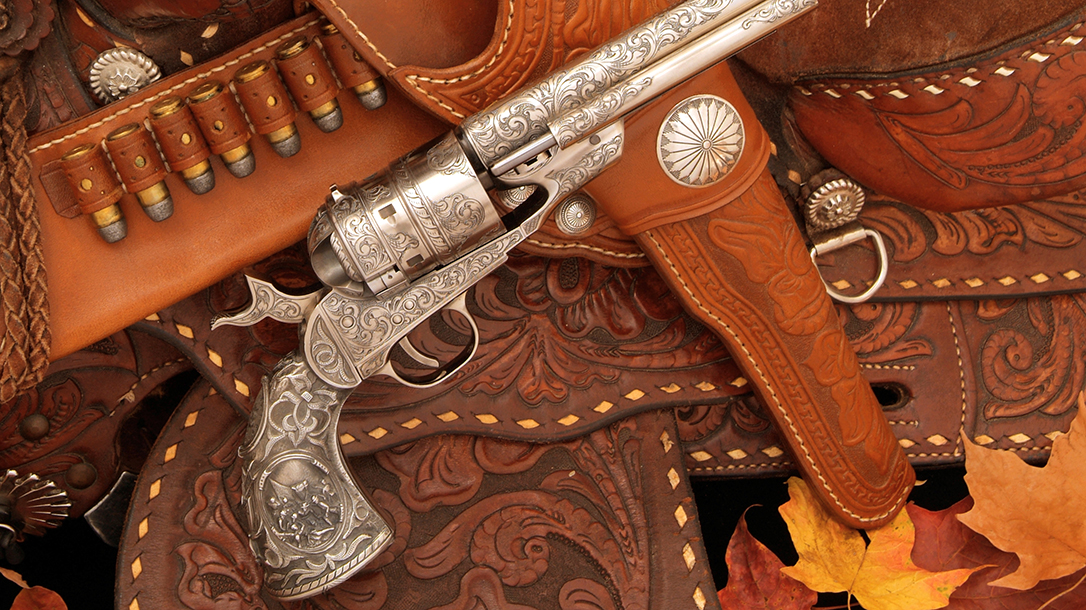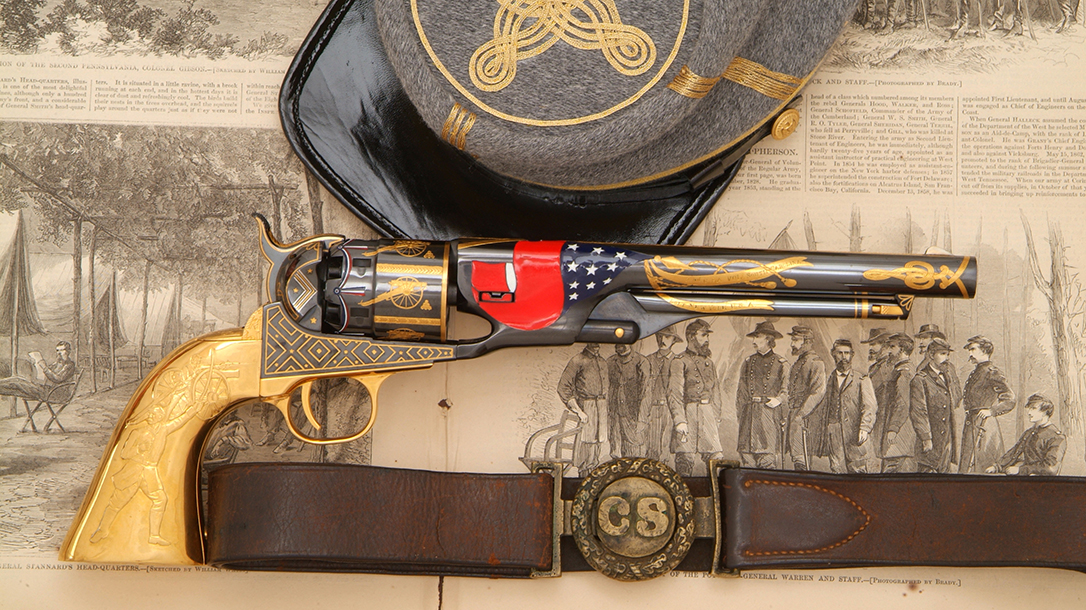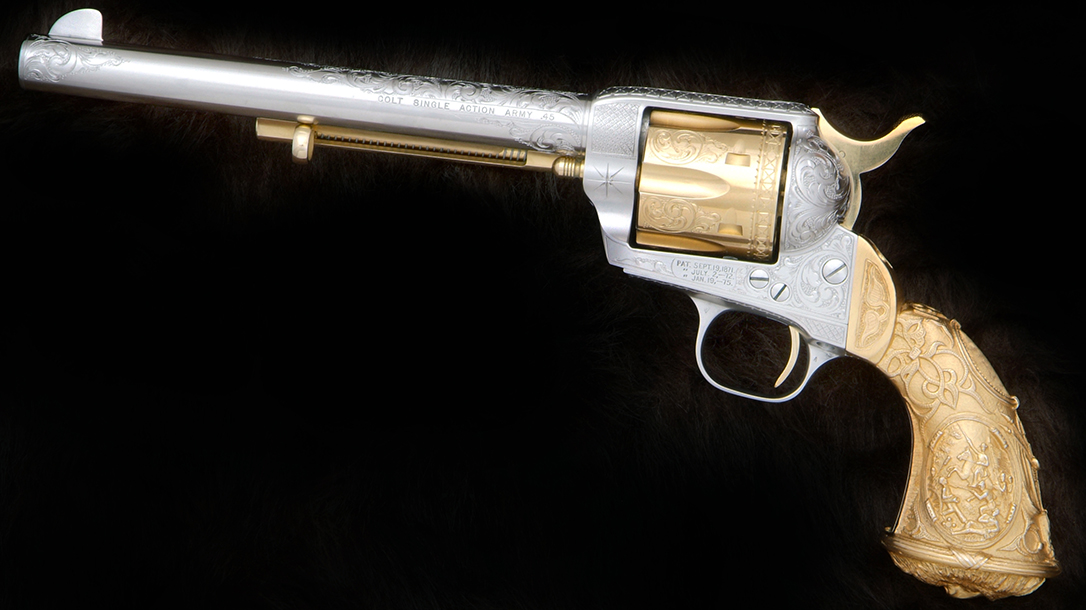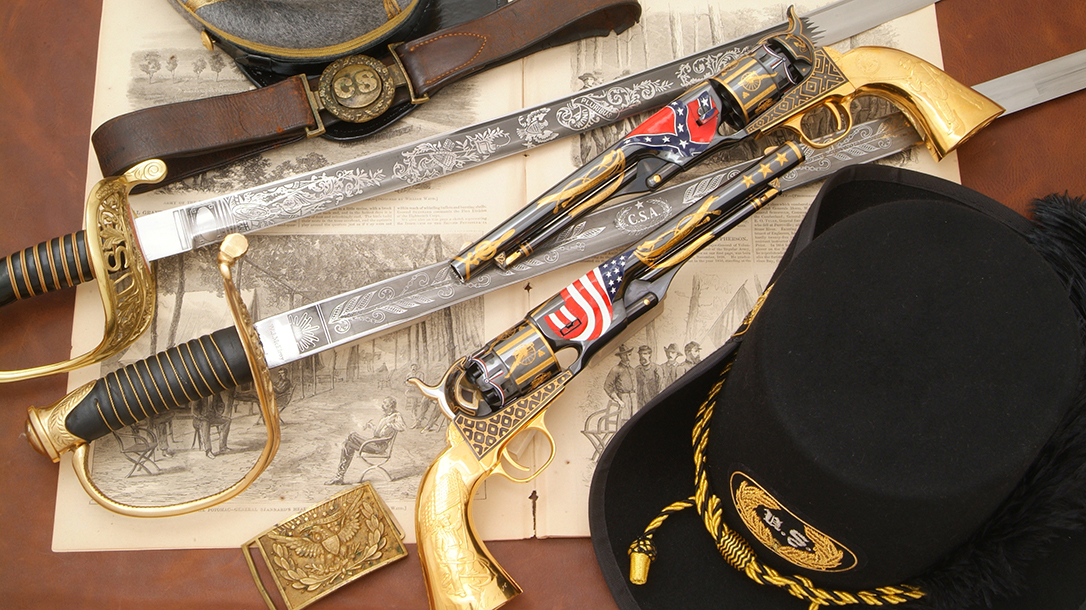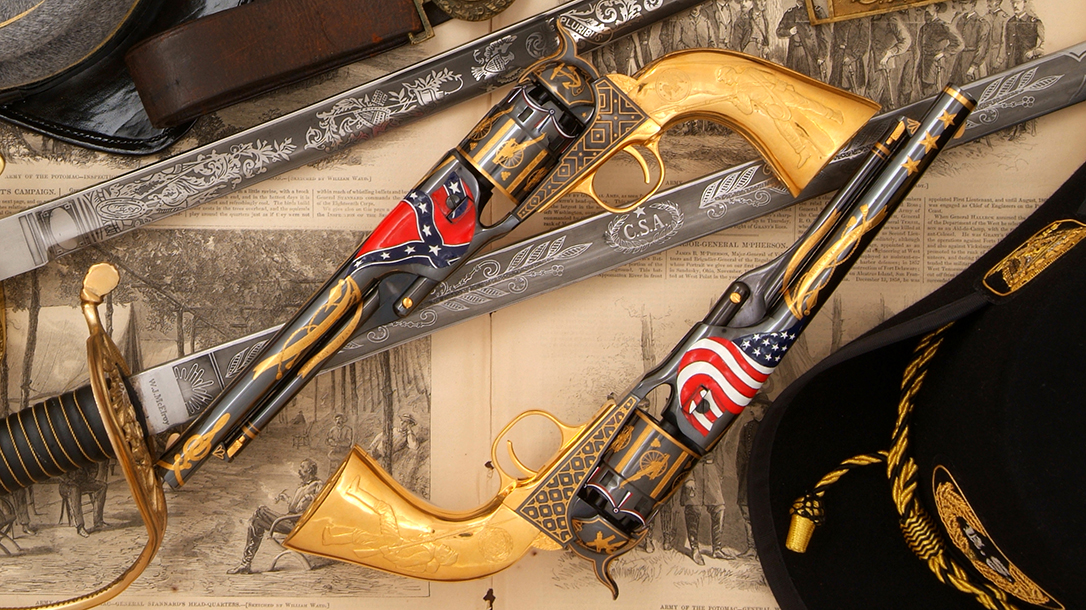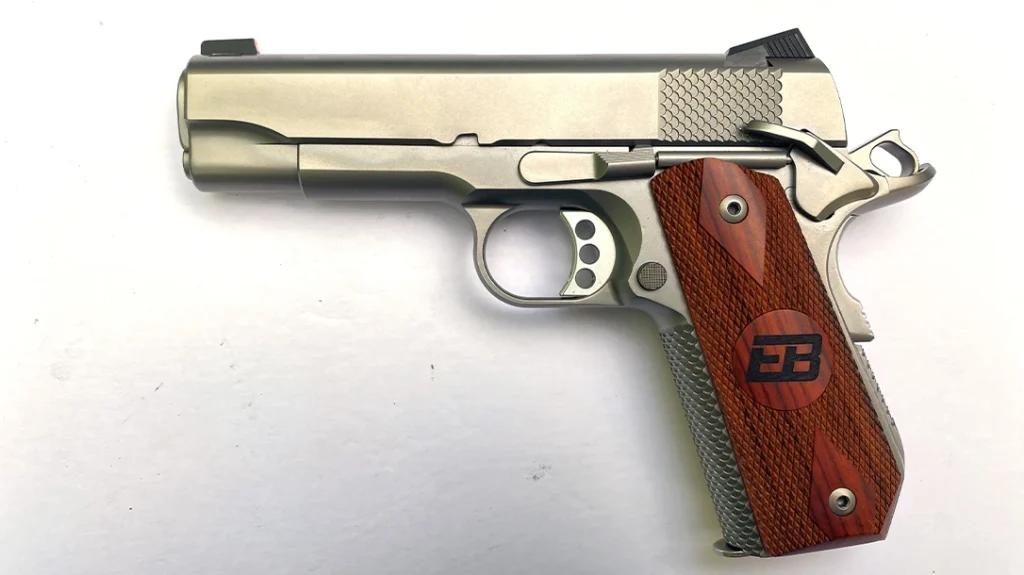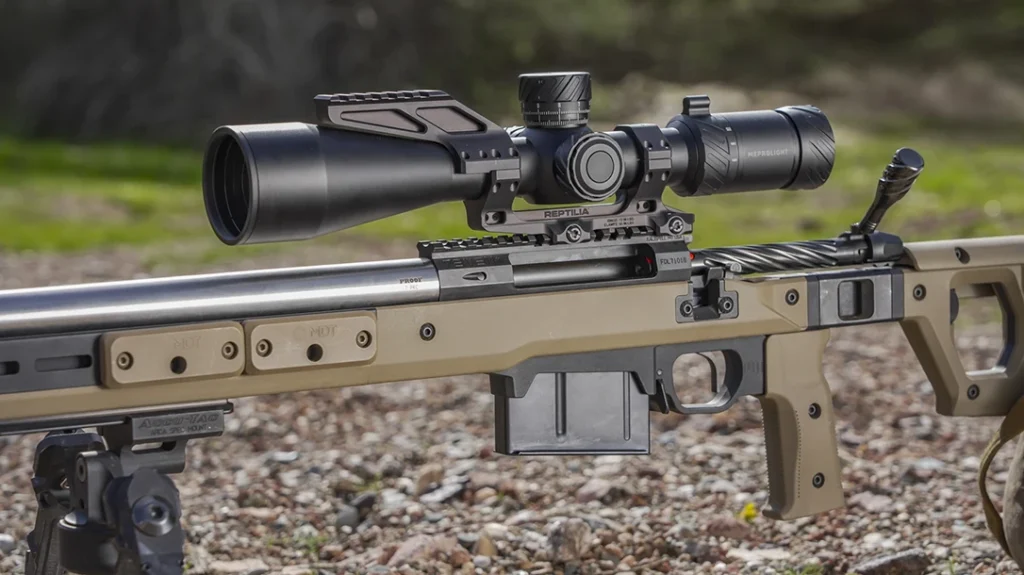Today, you wouldn’t think of Tiffany & Company as a place to purchase a gun, unless it was made out of diamonds, but there was a time when one of the finest gifts a gentleman could receive was a custom pistol purchased from the House of Tiffany in New York.
Charles Lewis Tiffany and John B. Young founded the firm in 1837. It was known then as Tiffany & Young. When Jabez L. Ellis joined the company, it became Tiffany, Young & Ellis, a boutique catering to New York and New England society. Jewelry wasn’t the company’s principal line at the time. In fact, fine imported silver was their stock in trade up until 1853. That’s when Charles Tiffany took control of the company.
Advertisement — Continue Reading Below
Tides Of War
The new Tiffany & Co. began manufacturing its own products in the 1850s with the help of New York silversmith John C. Moore and his son, Edward C. Moore. In 1861, the Civil War put Tiffany into the business of producing exquisitely engraved militaria, beginning with fine presentation swords. Tiffany’s elite clientele included Generals Ulysses S. Grant and William Tecumseh Sherman as well as Admiral David G. Farragut, according to R.L. Wilson’s Steel Canvas: The Art of American Arms.
The War Between the States also encouraged Tiffany to venture into the field of engraved and embellished presentation firearms, and to become the exclusive New York and New England dealer for Henry Deringer—the man, not the gun. Colt became a Tiffany customer during the war, as did Smith & Wesson. Both companies used silver Tiffany grips on their most elaborately engraved pistols.
In the U.S. today, engraved weapons produced throughout the Civil War and the settling of the American West are among the most coveted by antique arms collectors. “During Samuel Colt’s lifetime, approximately 600,000 Colt percussion pistols of all types were manufactured, and only a fraction of those were engraved presentation models,” noted late Colt authority, author and historian R.L. Wilson. “In his entire career, Colt may have given away as many as 3,500 presentation pistols to military officers, foreign dignitaries and heads of state.” These 19th century arms have become the most prized Colts of the 20th and 21st centuries, with many cased, engraved models valued today at well over $1 million.
Advertisement — Continue Reading Below
Tiffany Style
Between 1861 and 1875, Tiffany created elaborate cast-metal grips for Colt revolvers. According to Wilson, they were “more reminiscent of the hilting on presentation swords of the period.” Tiffany created three basic grip designs, with the most popular portraying Civil War battle scenes. The American and Mexican eagles were the next most popular, and the rarest was known as “The Missionary and Child.” The back of the grip had a portrait of Lady Justice bearing a cross, with a crouching American eagle over a shield produced in high relief on the butt cap.
Every Tiffany design had a presentation escutcheon just below the hammer (with the exception of the Missionary grip) and a large buttplate, usually with an American eagle, though there were other designs. The cast Tiffany grips featured either silver or gold plating and occasionally a combination of both, particularly on 20th century examples.
Advertisement — Continue Reading Below
The Tiffany “influence” in grip design was prolific throughout the 1860s and well into the 1870s and 1880s. Though this design was often called “Tiffany gripped,” it didn’t necessarily mean the grip was actually cast by Tiffany & Co. In fact, most were not. Wilson was of the opinion that most of the grips were actually done by the Ames Sword Company of Massachusetts, which also manufactured highly embellished swords for Schuyler, Hartley & Graham. Additionally, John Quincy Adams Ward, a prominent American sculptor, designed the Justice and American eagle pattern Tiffany grips. He also worked for the Ames Sword Company.
Tiffany Colt Production
Many of the “Tiffany-gripped” Colts sold in the 1860s and 1870s were marketed through the New York retail firm of Schuyler, Hartley & Graham, which employed L.D. Nimschke and his shop as their “in-house” engraver, thus many of the finest Tiffany-style Colts were Nimschke engraved. Others were done by the Nimschke shop or in the Nimschke style by individual engravers hired by Schuyler, Hartley & Graham. Tiffany-style grips adorn Colt cartridge conversions of the 1860 Army and 1851 Navy as well as Colt’s Pocket Models, Peacemakers and later offerings.
In Steel Canvas, Wilson notes that Tiffany produced a number of engraved Colt pistols in the 19th century. He also notes that the New York firm continued to produce presentation pistols into the 20th century. Tiffany catalogs for 1900 through 1909 advertised “Revolvers of the most improved types, mounted in silver, carved ivory, gold, etc., with rich and elaborate decorations.” Tiffany briefly revived its exclusive art of engraving fine pistols in the early 1980s, much through the efforts of George A. Strichman, then chairman of Colt Industries, who commissioned three gold- and silver-mounted Tiffany Colts. According toe Wilson, “That really marked the revival of the Tiffany tradition.”
Advertisement — Continue Reading Below
The next most significant return to the Tiffany design came in Tiffany-style 1860 Army revolvers manufactured by the Colt Blackpowder Arms Company from 1998 to 2002. Hand-engraved in the L.D. Nimschke vine scroll style—as originally sold by Schuyler, Hartley & Graham in the 1860s—the Colt reproductions were silver plated with 24-karat-gold-plated cylinders, loading levers, hammer and triggers. The engraving was accented by silver-plated Tiffany grips with Civil War battle scenes. Priced at $5,000 when they were introduced, it is estimated that fewer than 100 were made.
Truly Elaborate
Interestingly, the very last Tiffany-designed Colt pistols were also the most elaborate ever produced. They were made in the late 20th century. The unique cased set was designed by Tom Watts of Tiffany & Co. in 1992 and handcrafted by master engraver Andrew Bourbon, the protégé of the legendary Alvin A. White.
Advertisement — Continue Reading Below
White continued to engrave into the late 1990s and passed away at age 91, in May of 2006, considered a modern-day Gustave Young. Wilson wrote, “In the annals of firearms engravers, he was one of the greatest in history. He probably did more guns for famous people than any other American engraver of the 20th century.” White created engraved pistols for Tiffany & Co., heads of state, and Presidents John F. Kennedy, Lyndon B. Johnson, Gerald Ford and Ronald Reagan. Having mastered his skills under White, Andrew Bourbon was perhaps the only American engraver who could have taken on the Tiffany & Co. project.
The intricate design incorporated the use of hand engraving with brushed gold inlay, castings for the grips and a unique flexible cloisonné-like process called ceramitation. Bourbon explained that ceramitation is commonly used in the jewelry industry. It is a two-part epoxy that is colorized and dries to a very hard, glass-like surface. It can be shaped, and that is exactly what was needed for the elaborate flags over the tops of the barrels and the banners surrounding the backs of the cylinders.
Complexities & Difficulties
The complexities of making the guns eliminated the possibility of using enamel. Why? Because you couldn’t do any bluing after the enamel was applied. If the bluing was done first, you couldn’t use the enamel. Ceramitation could be heated just like bluing to a low temperature of around 200 to 250 degrees to have the chemicals activate and harden. This was the first time the process had been used on such a large area, compared to jewelry. And it worked perfectly.
Advertisement — Continue Reading Below
As Wilson notes in Steel Canvas, “The ceramitation was inlaid just as you would with gold or silver, so there is a trough for each part of the flag, staff and banners individually cut into the gun as a pattern, and then the individual parts of the flag done by colors and inlaid piece by piece, that’s the strips and stars, gold banners, all separately, and then baked to set and harden on a rotisserie in a special oven. It was a very intensive process.”
The grips, featuring Union and Confederate soldiers and armaments—a completely new approach for Tiffany grip designs—were hand-carved castings covered in 24-karat gold plating. The gold stars and bands for the barrels, the cannon on the cylinders and the patterns on the frames and backstraps were all hand-cut and inlaid.
Advertisement — Continue Reading Below
No Comparisons
Taking more than a year to complete, the guns cost $15,000 to make in 1992. As has often been the case with custom-built Civil War commemoratives, only one set was produced. The original commission was for arms collector Thomas A. Conroy in 1992. Following completion, the Colts changed hands and went into a private collection for a number of years. They then sold again to another major arms collector. As the last Tiffany & Co. Colts, their value today is certainly far greater than the original $15,000.
Although modern-day firearms based on Colt percussion-era pistols are still done with gold inlay and engraving, and some even with gold and silver Tiffany-style grips, the most extraordinary examples have been based on second-generation reproductions produced by the original Colt Blackpowder Arms Company and Colt. The second-generation models can even be lettered to confirm their authenticity as Colt firearms. None, however, ever exceeded the last Tiffany Colts, a pair of 1860 Army revolvers that would even have impressed Charles Lewis Tiffany himself.
This article is from the Summer 2019 issue of Guns of the Old West magazine. Grab your copy at OutdoorGroupStore.com. For digital editions, visit Amazon.
Advertisement — Continue Reading Below
